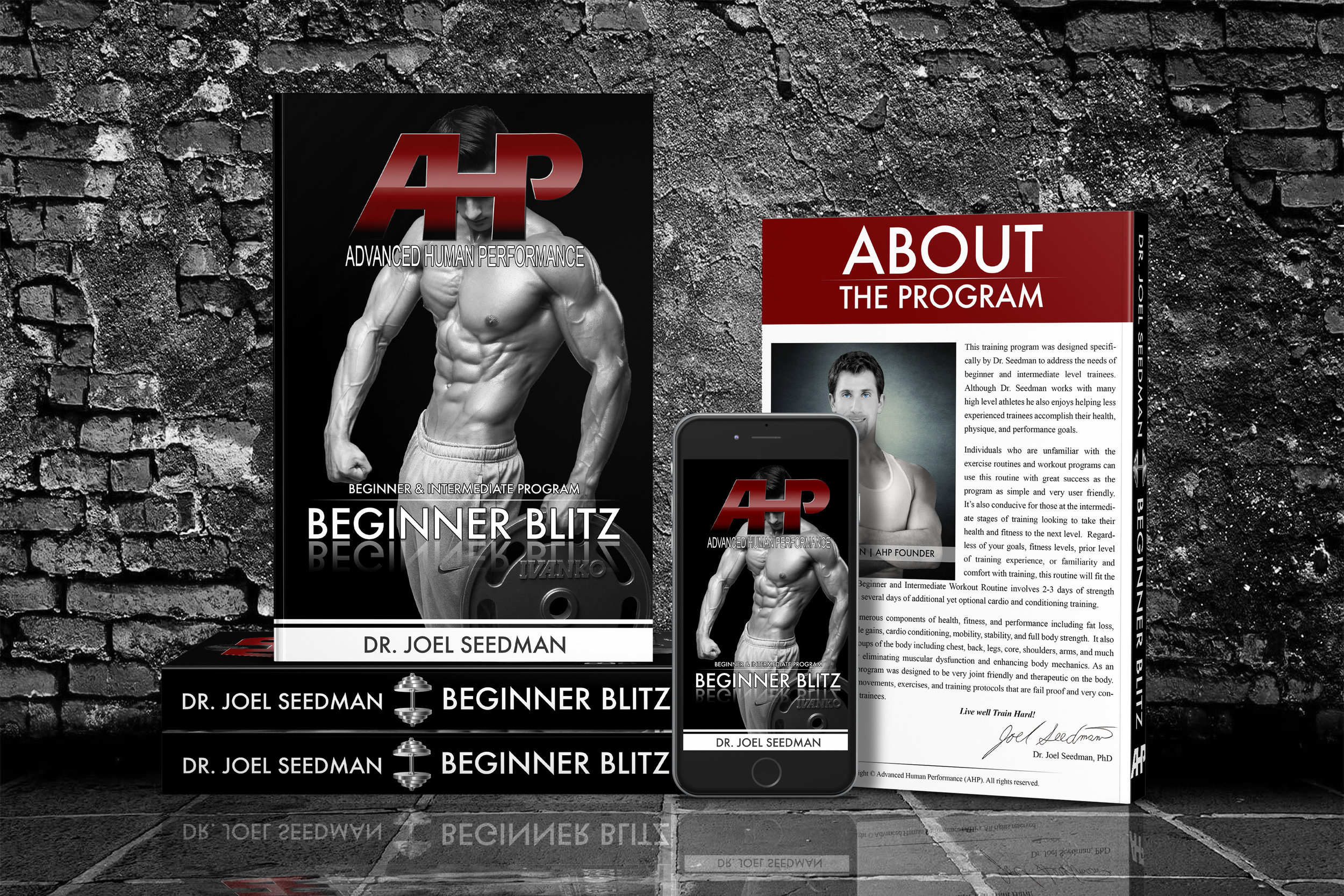Use The Trap Bar For Cambered Bar Squats
Dr. Joel Seedman, Ph.D.
If you haven’t figured it out by now I’ve got a special place in my heart for the trap bar as it’s one of the most versatile pieces of equipment there is. You can turn it, flip it, lift it, hoist it, roll it, tilt it, and yes that’s right, you can even wear it. In fact by placing the trap bar on your shoulders you can essentially turn the trap bar into a cambered squat bar.
Furthermore, this particular squat variation provides 10 unique benefits that are difficult to replicate with any other training tool including traditional cambered squat bars. Here’s what I mean.
1. Out of all squat variations I’ve ever used with myself or my athletes the trap bar cambered squat is by far the most effective variation I’ve used for teaching the lifter to set their hips back and avoid excessive anterior knee drift. Simply put you’ll be forced to employ optimal squat mechanics and avoid the common mistake of keeping an overly upright position. That’s because the lifer will be required to maintain a slight hip hinge throughout and load through their heels and hips in order to keep the bottom end of the bar from moving away from them. In addition, an overly upright position will cause the bar to slip off their upper back and traps due to the unsteady hanging nature of the trap bar.
2. Similar to the above, the cambered trap bar squat provides immediate feedback about bar path and squat mechanics particularly in regards to anteroposterior shifting. Even the slightest body shift forward will cause the bottom of the bar to rotate out and away from the lifter. To keep the bar close to the body throughout the lifter will be required to produce perfectly vertical force vectors. And yes, the only way to accomplish this is by using optimal hip hinge mechanics and 90 degree joint angles which leads to my next point.
3. The cambered trap bar squat ingrains optimal squat depth as the lifter will be forced to use a squat depth somewhere between 90 degrees and parallel (110 degrees). That’s because the bottom end of the bar touches the thighs at approximately these optimal joint angles. Simply put this variation keeps the individual from collapsing at the bottom of the squat and reinforces the idea of maintaining crisp and tight squat mechanics. Read more about proper squat depth here.
4. When first attempting the trap bar cambered bar squat, many lifters will notice that in order to reach the 90 degree position they’ll need to spread their knees and hips apart laterally (an important squat cue) in order to accommodate the bottom end of the trap bar and allow it to sit between their knees. Without optimal knee spread the squat depth will be cut short at 20-30 degrees above the parallel position as the bottom of the bar will run into the thighs and knees too early in the eccentric phase of the movement. In other words this teaches the lifter to produce optimal knee spread and avoid valgus knee collapse.
Photo Courtesy: Shannon Adams
5. The trap bar cambered squat requires the lifter to produce an incredibly tight shelf for the bar to sit on by keeping the traps and lats and upper back thoroughly engaged throughout the movement. Otherwise the bar won’t sit well on the upper back and will feel as if it’s going to slide or slip off.
6. On a similar note, in order to produce a tight shelf for the bar to sit on the lifter will need to maintain a neutral spine position particularly at the cervical spine. In fact it’s almost impossible to hyperextend the cervical spine and look up given the way the trap bar sits on the upper traps and shoulders. If you have difficulty finding a neutral spine position or neutral head placement during the squat, this provides an immediate fix.
7. Besides maintaining a rigid upper back and tight upper shelf for the bar to sit on, the lifter will also be required to pull the bar into their back throughout by flexing their lats. This helps secure the bar onto the body and ensure it doesn’t move or shift throughout the set. The “pull the bar into your back” cue is one of the most important upper body tips for ingraining proper squat technique. Fortunately this cue is a “must” when performing trap bar cambered bar squats.
8. Most cambered squat bars essentially have one straight-grip option (although the hands can move up or down slightly on the handles). This can feel moderately restricting depending on the size of the individual or their specific anthropometrics. The trap bar provides a more natural angled grip as well as other potential options to place the hands thereby accommodating a number of different body types and shoulder structures.
9. With the exception of hardcore powerlifting gyms, very few facilities have cambered squat bars. However, the trap bar is now becoming more and more commonplace not only in hardcore strength settings but in standard fitness centers and commercial gyms. With that said any gym that carries a trap bar also provides a setting where you’ll also be able to perform cambered squat bars. In fact, before performing these with the trap bar, I myself had never had the opportunity to perform cambered bar squats as I simply didn’t have access to this particular specialty bar.
10. The cambered trap bar squat protocol is very versatile and can be modified and applied to a number of variations including accommodating resistance (bands and chains), hanging band protocol, 1.5 rep technique, eccentric isometrics, dead stop reps, and even good mornings, lunges, Bulgarian squats, and split squats.
Cambered Trap Bar Lunges
If you’re looking for a split squat variation that will immediately help clean up mechanics and form on your lunge technique try performing split squats, lunges, and Bulgarian squats with the cambered trap bar protocol as demonstrated by my awesome client Leslie Petch.
Besides requiring strict motor control, and smooth execution, the hanging nature of the trap bar on your body helps pull the hips straight down. Most individuals when performing lunges and split squats allow the hips and knees to drift forward as they descend into the eccentric phase of the movement. This variation helps cue the lifter to move with perfectly vertical force vectors and no wasted horizontal forces or energy leaks as the lifter can literally feel the hips being cued into the appropriate position (i.e. straight down).
In addition, any remaining anterior knee drift or forward weight shift will make it impossible to descend into the bottom position as the bar will run into the front knee. To move into the bottom 90 degree position the lifter will be required to set the hips back, produce a moderate forward lean, maintain optimal hip hinge mechanics throughout, and avoid an overly upright position. And yes, all of these features represent optimal characteristics of a proper lunge or split squat which the cambered trap bar protocol helps facilitate.
On a side note, depending on the length of your stride as well as individual anthropometrics some individuals may find that they must push forward every so slightly on the bar to help it move past the knees at the bottom. However this should be very minimal and in many scenarios unnecessary if in fact proper lunge mechanics described above were employed.
Cambered Trap Bar Good Mornings
The cambered trap bar protocol is very conducive for applying to good mornings as the hanging nature of the trap bar makes the movement feel more natural than traditional good mornings. In fact, most of my athletes are able to use heavier loads with less stress to the low back when performing good mornings with the trap bar.
Here's one of my football athletes Ike Onike showing how it's done. Similar to the cambered trap bar squats, applying this technique to good-mornings not only thoroughly taxes the posterior chain but it requires and instills proper mechanics, motor control, enhanced spinal rigidity and optimal range of motion.
Single Leg Variations
This trap bar cambered bar protocol can also be applied to single leg squats, single leg good mornings, and split squat variations. Here I have NFL quarterback Taylor Heinicke performing the single leg good morning variation to target his glutes and hamstrings unilaterally.
Just like any single leg hip hinge exercise, focus on maintaining a neutral spine while keeping a soft knee on the working leg and kicking the back heel up towards the ceiling while maintain a 90 degree angle in that back leg. Be prepared to fire your core and foot and ankle stabilizers like mad as the level of balance and full body stability involved is inordinately high. As an added bonus these tend to be more low back and shoulder friendly than traditional good mornings.
Note About Setup
On a side note, regarding the issue of racking the trap bar in a cage and fitting enough plates, some individuals may find it more effective to set up boxes (one on each side of the bar) at approximately mid torso height to set the trap bar onto and rack it from there. In other words the plates would rest on the box. Depending on the width of the squat rack as well as the size of the bar (the one shown in the video is a slightly longer 75 pound trap bar) this will allow more plates to be loaded on the bar while making it easier to rack and unrack.
Vertical Cambered Trap Bar Squats
The cambered trap bar protocol can also be applied to squats in a vertical fashion as I show here. These provide even more feedback regarding force vectors as even the slightest forward weight shift will result in the bottom in tilting forward.
Additionally this represents one of the few squat variations where the lifter doesn’t need a squat rack or squat cage to perform back squat variations making it very convenient. Just make sure to use a very sturdy clip or double clip it.
For more information on programming movements such as trap bar cambered squat bar variations into your routine check out my Complete Templates.

























































